The MSI B350 Tomahawk Motherboard Review: Gaming On a Budget
by Gavin Bonshor on March 12, 2018 10:45 AM EST- Posted in
- Motherboards
- AMD
- MSI
- ATX
- Zen
- AM4
- B350
- Ryzen
- Tomahawk
- Raven Ridge
Board Features
The B350 Tomahawk is a solid option given the component choice and offers virtually everything you would expect from a $100 offering. One of the defining features of this particular B350 model is that it does technically support two-way CrossFireX multi graphics cards configurations. The top PCIe 3.0 slot, which has been reinforced with MSI’s Steel Armor, operates at x16 with a single GPU, whereas the second slot operates at x4, but is only PCIe 2.0.
| MSI B350 Tomahawk ATX Motherboard | |
| Warranty Period | 3 Years |
| Product Page | Link |
| Price | $95 |
| Size | ATX |
| CPU Interface | AM4 |
| Chipset | AMD B350 |
| Memory Slots (DDR4) | Four DDR4 Supporting 64GB Dual Channel Up to 3200 MHz |
| Video Outputs | HDMI 1.4, DVI-D, VGA |
| Network Connectivity | Realtek 8111H Gigabit |
| Onboard Audio | Realtek ALC892 |
| PCIe Slots for Graphics (from CPU) | 1 x PCIe 3.0 x16 |
| PCIe Slots for Other (from PCH) | 1 x PCIe 2.0 x4 2 x PCIe 2.0 x1 2 x PCI x1 |
| Onboard SATA | Four, RAID 0/1/10 |
| Onboard M.2 | 1 x PCIe 3.0 x4, on Front |
| USB 3.1 (10 Gbps) | N/A |
| USB 3.0 (5 Gbps) | 1 x Type-C Rear Panel 3 x Type-A Rear Panel 2 x Header |
| USB 2.0 | 2 × Header 2 x Rear Panel |
| Power Connectors | 1 x 24-pin ATX 1 x 8-pin CPU |
| Fan Headers | 1 x CPU (4-pin) 4 x System (4-pin) 1 x System/Pump (4-pin) |
| IO Panel | 3 x USB 3.0 Type-A 1 x USB 3.0 Type-C 2 x USB 2.0 Type-A 1 x Network RJ-45 (Realtek) 1 x HDMI 1.4 1 x VGA 1 x DVI-D 1 x Combo PS/2 6 x 3.5 mm Audio Jacks |
Even though the B350 Tomahawk doesn’t have support for NVIDIA SLI, users looking to utilize more than one graphics card should look towards the X370 chipset as this has far better options, and X370 supports SLI too. An interesting element is that this board does not have any USB 3.1 (10 Gbps) ports, despite the chipset supporting them.
Visual Inspection
The MSI B350 Tomahawk conforms to the usual ATX sizing (305 x 244mm) and features a shiny grey PCB with red accents on the power delivery heat sinks. This is a budget focused board, so the PCB is scarce beyond the aesthetics, but this is normal for a board of its price range.
On networking, the Realtek 8111H controller is located on the rear panel, and for audio is the Realtek ALC892 codec. Based on our performance numbers, the ALC892 as the low-end 7.1 option does perform a little bit worse than the slightly more expensive ALC1150 and ALC1220 codecs. The B350 Tomahawk does not feature a S/PDIF output, but rather it makes use of an additional 3.5mm audio jack which puts the total up to six on this particular model. The audio component section features an isolation line from the rest of the PCB to reduce inductance between the digital and audio traces, but there is no EMI shield on the codec. There are a set of Nippon Chemi-con gold audio capacitors to support the on-board audio.
There is a full compliment of DRAM slots on the MSI B350 Tomahawk, with support for up to a maximum of 64GB of DDR4, and the motherboard is listed up to DDR4-3200 for Ryzen CPUs/APUs or DDR4-2400 for Bristol Ridge APUs.
Underneath the darker grey heatsinks is a formidable (for the price range) set of midrange NIKOS MOSFETs, supplemented and controlled by a single AMD SVI2 compliant Richtek RT8894A PWM phase controller. The phases run in 4+2 configuration with the two being designed for the APU and SoC segments of the chip. With a lot of heat (pun intended) on motherboard manufacturers to improve the power delivery cooling, MSI has gone with a very reasonable offering of a metal bulk for better heat dissipation. It is nice to see a lower end board feature more function than flash, and a better design than some RGB enabled plastic.
Some users may care that the heat sinks do not feature RGB LED lighting, or any lighting for that fact, but MSI has implemented red LEDs on the rear to provide an ambient red glow (of sorts) when installed into a “closed” chassis. There is an additional 4-pin RGB header towards the bottom of the board.
One of the biggest differences between the B350 and X370 chipsets is storage support: the B350 chipset has native support for four SATA 6Gb/s ports, while the X370 chipset supports six. On the MSI B350 Tomahawk, two of the SATA ports are angled while the other two are vertical with the board. Typically this vertical arrangement is seen on cheaper motherboards. Along with the SATA ports is a single PCIe 3.0 x4 slot, suitable for NVMe drives up to 110mm.
On the rear panel, from left to right, there is a combination PS/2 connector, two USB 2.0 ports, a VGA video output, a DVI-D video output, a HDMI port, a USB 3.0 Type-C port, three USB 3.0 Type-A ports, a network port, and the audio jacks.
In the Box
The MSI B350 Tomahawk has a fairly limited set of accessories, but with that said, more than enough is included for an initial setup. We get the following:
- Driver Disk
- User & Quick Start guide
- AMD Screw CPU Cooler guide
- Rear I/O Plate
- Two SATA Cables (One right angled and one straight)
- Thank you card


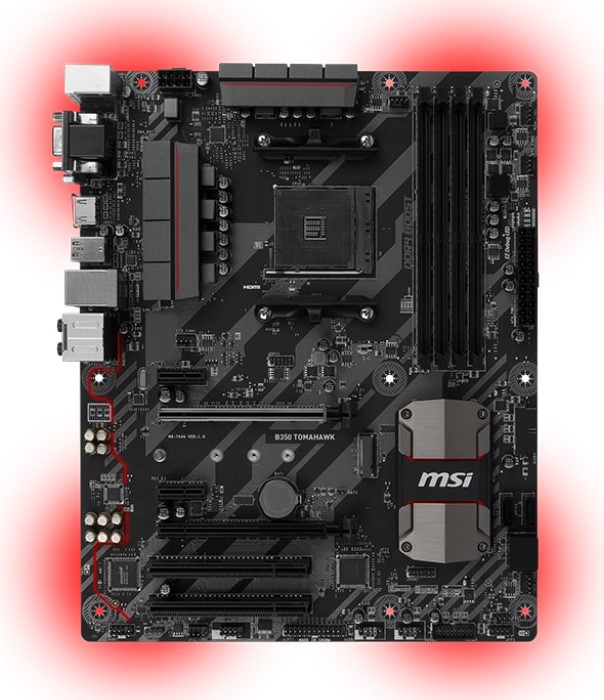
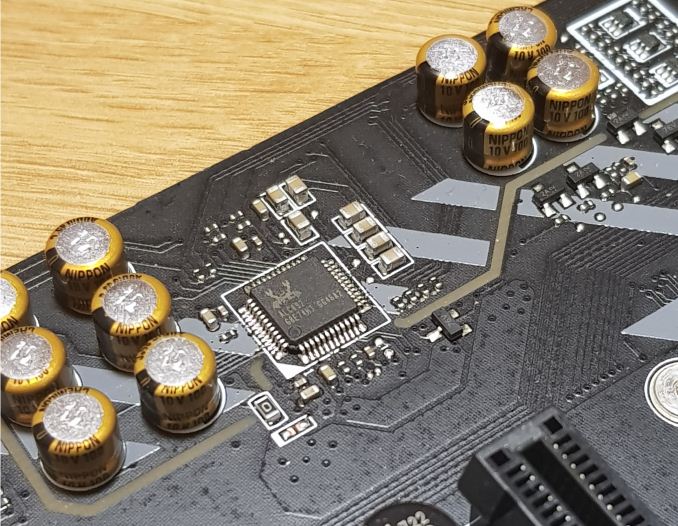
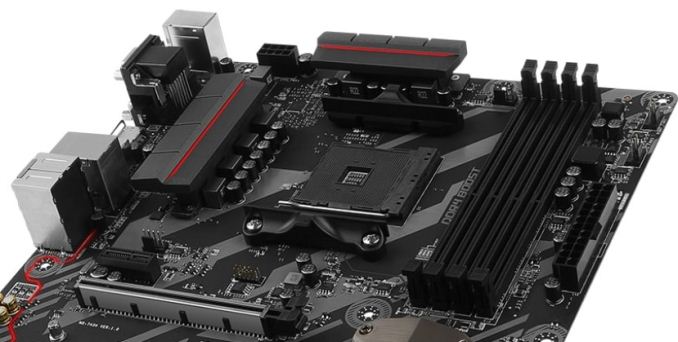
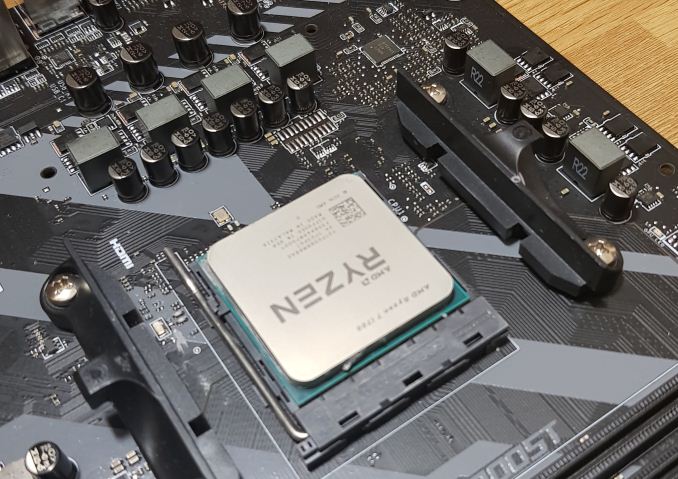
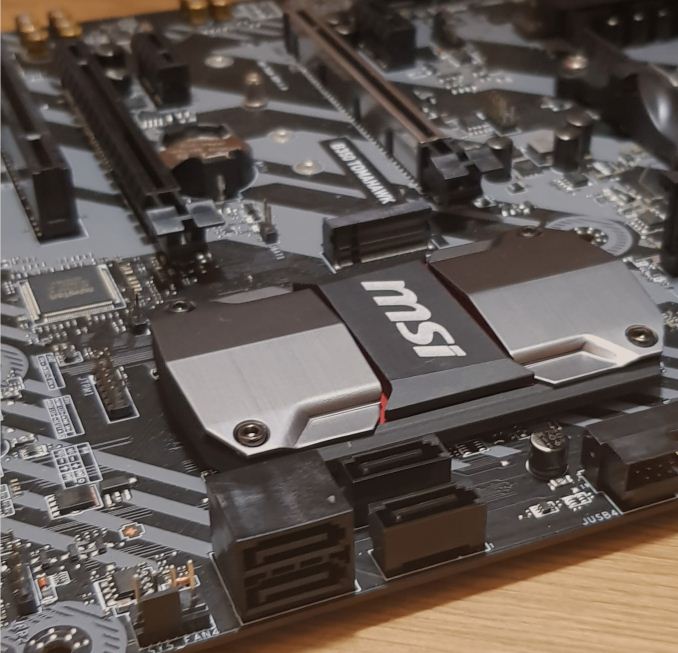

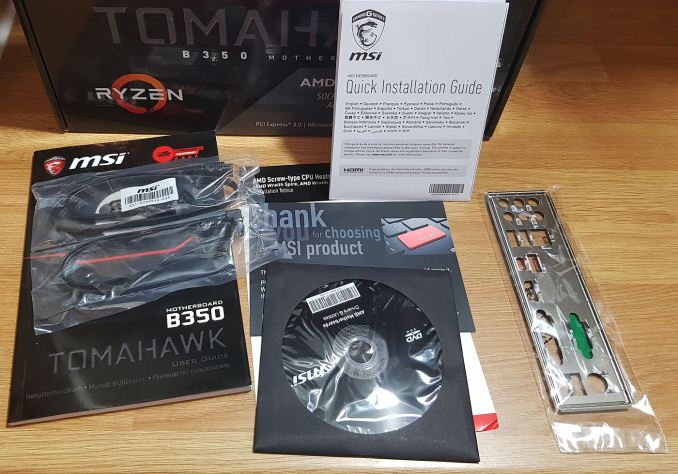








46 Comments
View All Comments
vkristof - Tuesday, March 13, 2018 - link
yeah: this has been driving me nuts.Many B350 motherboards do not list the full complement of TWO (2) USB 3.1 Gen ports that AMD states the chipset/FCH/whatever provides. Are there additional components that have to be added to the B350 to get the Gen2 speed to work?
unlockproject - Monday, August 1, 2022 - link
sometimes windowless chttp://sharepoint.bath.k12.va.us/tech/forum/Lists/...
Tsavo - Monday, March 12, 2018 - link
I have the Krait version of this. It takes forever (15s) to POST. Latest BIOS doesn't fix it, either.Other than that massive clanger, it's an ok board, but I'd certainly not recommend any AMD based MSI board based upon the long POST time.
artifex - Monday, March 12, 2018 - link
My MSI 970a-g43 (AM3+) hits the Windows login screen in about 5 seconds.I wonder what's happened between then and now, design-wise? Especially since mine's not a "gaming" board and I got it for about $30-40.
kepstin - Monday, March 12, 2018 - link
The change to DDR 4 ram hurt motherboard post times a fair bit. And the am4 boards, particularly with early bioses, might put you into a slow ram setup retry loop.That said, with the latest (1.C) bios on my tomahawk, and with Windows whql mode enabled (turns off legacy boot), I have nothing to complain about with post speed.
Tsavo - Monday, March 12, 2018 - link
I think you may be on to something here. I've been poking around, and found out that the BIOS of my GTX 660 doesn't support UEFI fast boot. I emailed EVGA for an updated version that supports it.Dollars to donuts, the UEFI bios is looking for signed devices and takes a long time to do it if it comes across ones that aren't.
artifex - Monday, March 12, 2018 - link
Yikes. Guess I should be looking for an update to that situation when the 450/470-based boards come out, before deciding to upgrade.TrackSmart - Monday, March 12, 2018 - link
Why the long post times for all of these modern motherboards? I thought my Ryzen motherboard was just poorly optimized (about 20 seconds to post; Also 20 seconds to wake from sleep). But it looks like this is one area where desktop motherboards have *not* improved performance-wise in the past 8 years.My 2010-era AMD system posts faster than my new Ryzen build. And it wakes from sleep in about 4-5 seconds instead of ~20 seconds. That is after all efforts to streamline the post times. My ~1 second improvement in post time mirrors the difference between "stripped" and "default" in this article, so I'm guessing that there's not a lot of improvement to be had, short of optimizations from the motherboard manufacturer themselves (ASUS in my case).
silverblue - Wednesday, March 14, 2018 - link
My Gigabyte GA-AB350 Gaming 3 has three Fast BIOS speed settings - Disabled, Enabled and Ultra Fast. The latter doesn't even show the BIOS before you get the Windows 10 logo, not a massive issue if you're happy with the APP Center within Windows instead of being able to go the BIOS directly.silverblue - Wednesday, March 14, 2018 - link
Yep, 9 seconds from on to Windows 10 logo, and another 5 to login screen. About 5 seconds from sleep (though some of that is the display turning back on). I should also explain that I have a Samsung 850 Evo 250GB as my boot drive, and that I'm running a Ryzen 5 1600 with 16GB DDR4 3000 CL16.